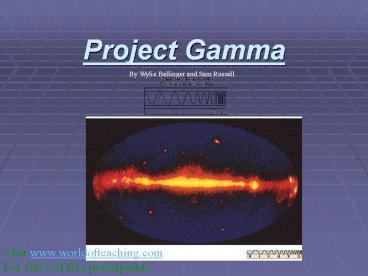Project Gamma - PowerPoint PPT Presentation
Title:
Project Gamma
Description:
EGRET Energetic Gamma Ray Experiment Telescope CGRO EGRET The Compton ... diffuse radiation and the measurement of the pion bump in the high ... – PowerPoint PPT presentation
Number of Views:145
Avg rating:3.0/5.0
Title: Project Gamma
1
Project Gamma
By Wylie Ballinger and Sam Russell
Visit www.worldofteaching.com For 100s of free
powerpoints
2
What are Gamma Rays?
- The most potent particles on the electromagnetic
scale and the known universe. - 1 TeV (1,000,000,000,000 eV, where an optical
photon has an energy of a few eV
http//imagine.gsfc.nasa.gov/docs/science/how_l2/g
amma_detectors.html - Smallest wavelength
- Quite rare.
- Only created by radioactive atoms and nuclear
reactions. - The hottest regions of the universe produce them.
- Formed by Supernovae, Pulsars, Neutron Stars,
Black holes, and Gamma Ray Bursters.
electron volt The change of potential energy
experienced by an electron moving from a place
where the potential has a value of V to a place
where it has a value of (V1 volt). This is a
convenient energy unit when dealing with the
motions of electrons and ions in electric fields
the unit is also the one used to describe the
energy of X-rays and gamma rays. A keV (or
kiloelectron volt) is equal to 1000 electron
volts. An MeV is equal to one million electron
volts. A GeV is equal to one billion (109)
electron volts. A TeV is equal to a million
million (1012) electron volts.
http//imagine.gsfc.nasa.gov/docs/science/how_l2/g
amma_detectors.html
3
Seeing in Gamma
- Explorer XI launched first satellite in 1961 was
the first gamma ray receiver. - It picked up fewer than 100 cosmic gamma-ray
photons total. - CGRO satellite.
- The moon gives off more Gamma Rays than the sun.
- Mirrors dont work
4
How Do We See Gamma?
- 1-30 MeV Is the ideal range that we wish to see.
- Active galaxies, pulsars, and solar flares.
- Compton Scattering and how it works.
5
How Do We See in Gamma? Continued
Im a visual person
http//learntech.uwe.ac.uk/radiography/RScience/in
teractions/comptonscatter.htm
6
So How Does That Work Again?
- Crystal Scintillators
- Crystals that emit low energy light (usually
visible) when hit by high energy light such as
gamma radiation. - Pair Production
- The physical process whereby a gamma-ray photon,
usually through an interaction with the
electromagnetic field of a nucleus, produces an
electron and an anti-electron (positron). The
original photon no longer exists, its energy
having gone to the two resulting particles. The
inverse process, pair annihilation, creates two
gamma-ray photons from the mutual destruction of
an electron/positron pair. http//imagine.gsfc.nas
a.gov/docs/dict_jp.htmlpair_production - CGRO uses compton scattering and pair
production. - Launched in April 5th, 1991 on Atlantis shuttle.
Had a visual range of 30 KeV to 30 GeV - Burst And Transient Source Experiment (BATSE),
the Oriented Scintillation Spectrometer
Experiment (OSSE), the Imaging Compton Telescope
(COMPTEL), and the Energetic Gamma Ray Experiment
Telescope (EGRET). http//cossc.gsfc.nasa.gov/ - Returned to Earth on June 4th 2000.
- Gamma-ray Large Area Space Telescope is being
sent up by Nasa in 2007.
7
Gamma Ray Bursters
- Does what it says on the box.
- http//imagers.gsfc.nasa.gov/ems/gamma.html
- The most energetic things in the universe that we
know of. - More energy in 10 seconds than our sun can
produce in its entire liftime of 10,000,000,000
years!
8
GLAST
- Gamma-Ray Large Area Space Telescope Large Area
Telescope - Funded Jointly by the US, Japan, France and
Sweden - Accuracy of 30 Arc seconds
- Launch in 2006
9
CGRO
- Compton Gamma Ray Observatory
- Four telescopes on it
- 1. BATSE
- Base and Transient Source Experiment
- 2. OSSE
- Oriented Scintilliation Spectrometer Experiment
- 3. COMPTEL
- Imaging Compton Telescope
- 4. EGRET
- Energetic Gamma Ray Experiment Telescope
10
CGRO EGRET
- The Compton Gamma Ray Observatory Energetic Gamma
Ray Experiment Telescope - 80 Field of View
- Launched in 1991 as an Experimental Program
- Re-entered in 2004
11
Major EGRET Discoveries
- The finding of a new class of objects--high
energy gamma-ray emitting blazars, or grazars - The emission of high energy gamma-rays from a
gamma ray burst for over an hour, with some gamma
rays having energies over a GeV and two having
energies over 10 GeV. - The observation of an increased fraction of
pulsar electromagnetic radiation going into gamma
rays as the age of the pulsar increases to a
million years - The determination with high certainty that cosmic
rays are galactic - The detailed mapping of the galactic diffuse
radiation and the measurement of the pion bump in
the high energy gamma-ray spectrum - The absence of microsecond bursts and its
implication for certain unification theories - The long trapping time of over ten hours for
energetic solar particles following a flare - A measurement of the diffuse, presumably
extragalactic, high energy gamma ray spectrum - http//lheawww.gsfc.nasa.gov/docs/gamcosray/EGRET/
highlights.html
12
(No Transcript)
13
INTERGRAL
- International Gamma-Ray Astrophysics Laboratory
- European Space Agency
- Demark, France, Germany, Italy, Spain and
Switzerland - Czech Republic and Poland
- With help from Russia and US
- Giant molecular cloud in the center of the galaxy
that was just recently discovered
14
Gamma-Ray Burst over 40 Seconds
http//www.rssd.esa.int/Integral/integ_images.html
15
A Cool Picture !!!
16
Sources
- http//imagers.gsfc.nasa.gov/ems/gamma.html
- http//science.nasa.gov/newhome/headlines/ast09feb
99_1.htm - http//www.wordiq.com/definition/Gamma_ray_burst
- http//imagine.gsfc.nasa.gov/docs/science/how_l2/c
ompton_scatter.html - http//imagine.gsfc.nasa.gov/docs/science/how_l2/g
amma_detectors.html - http//imagine.gsfc.nasa.gov/docs/science/how_l1/g
amma_detectors.html - http//www.astro.utu.fi/cflynn/astroII/l7.html
- http//learntech.uwe.ac.uk/radiography/RScience/in
teractions/comptonscatter.htm - http//imagine.gsfc.nasa.gov/docs/science/how_l2/g
amma_scintillators.html































